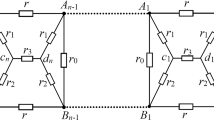Abstract
The capacity of potentially inverse multielement two-terminal devices to become complementary two-terminal devices under conditions that differ from the condition of invertibility is well known. For such two-terminal devices, both the generalized (classical) condition of complementarity and particular conditions in the form of a group of mathematical expressions are satisfied. Examples of potentially inverse two-terminal devices of the other form, which theoretically cannot be inverse two-terminal devices, are also known. For these two-terminal devices, the generalized condition of complementarity cannot be satisfied. It has been established for such two-terminal devices that, when the generalized condition of complementarity is not satisfied, the group of particular conditions of complementarity holds true and they become pseudocomplementary two-terminal devices. The number of the particular conditions of complementarity equals the number of the elements in the potentially inverse two-terminal devices of two structures selected. The number of the elements in the two-terminal devices and their connection have been justified. Variants of using pseudocomplementary two-terminal devices based on potentially inverse two-terminal devices are presented. The former devices allow a reduction of the number of inverse model elements in bridge circuits, the grounding of all multielement two-terminal devices present in the bridge circuits, and the manufacture of bridges with extended functional capabilities.




Similar content being viewed by others
REFERENCES
Peredelskiy, G.I., The properties of potentially inverse multi-element bipolar electrical circuits, Izv. Vyssh. Uchebn. Zaved., Elektromekh., 2014, no. 1.
Peredelskiy, G.I., Pseudo-complementary, pseudo-inverse, and pseudo-equivalent bipolar electrical circuits, Elektrichestvo, 2012, no. 12.
Guillemin, E.A., Synthesis of Passive Networks: Theory and Methods Appropriate to the Realization and Approximation Problems, New York: Wiley, 1957.
Peredelskiy, G.I., Mostovye tsepi s impul’snym pitaniem (Bridge Circuits with Pulse Power), Moscow: Energoatomizdat, 1988.
Peredelskiy, G.I., A property of potentially frequency independent two-terminal networks, Electr. Technol. Russ., 2000, no. 4.
Peredelskiy, G.I. and Shevelev, S.S., The properties of four-pole network of four structures, Elektrichestvo, 2015, no. 12.
Author information
Authors and Affiliations
Corresponding author
Additional information
Translated by O. Lotova
About this article
Cite this article
Peredelskiy, G.I., Pleskonos, L.V. Properties of Potentially Inverse Multielement Two-Terminal Devices. Russ. Electr. Engin. 91, 237–242 (2020). https://doi.org/10.3103/S1068371220040069
Received:
Revised:
Accepted:
Published:
Issue Date:
DOI: https://doi.org/10.3103/S1068371220040069




